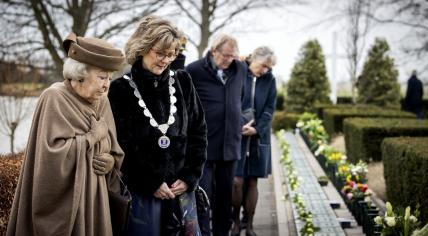
70th anniversary of 1953 flood disaster commemorated in Netherlands
“The trauma is massive, very massive, and the enormous loss remains. The elderly undoubtedly think back to everything that has been lost forever.” That is what mayor Ada Grootenboer-Dubbeldam of Goree-Overflakkee (Zuid-Holland) said at the commemoration of the flood disaster of 9153 in Oude-Tonge. Princess Beatrix was among the attendees.
In the middle of the night of 1 February 1953, the dikes broke in many places in Zeeland and Zuid-Holland. The resulting floods killed 1,836 people. Oude-Tonge lost the most resident, with 305 lives lost. “They died when their house collapsed or drowned when the water took them. Or they succumbed to the cold and exhaustion because it took too long for help to arrive. The water was relentless,” Grootenboer-Dubbledam said.
The mayor, King’s Commissioner Jaap Smit, and others laid wreaths and flowers at the Heerendijk cemetery in Oude-Tonge. Princess Beatrix also attended that ceremony, as did many others, despite the strong wind.
Infrastructure Minister at Ouwerkerk commemoration
Minister Mark Harbers of Infrastructure and Water Management attended the commemoration in Ouwerkerk in Zeeland. The Netherlands is the best-protected delta area in the world, but the work to defend the land against the water is never finished, he said. Certainly not now that climate change poses new challenges for water management.
Zeeland lost 865 residents to the 1953 flood. “We have been on constant alert since 1 February 1953,” said the Minister during a speech at the Watersnoodmuseum on Schouwen-Duiveland. “That never went away.” Despite happening 70 years ago, the flood disaster is still “extremely topical” and “still affects us deeply,” the Minister said. “I notice that in the emotions that this day still evokes in so many people. To this day. I also notice it in myself when I hear the heartbreaking stories of mothers seeing the bed with their children drift away in the night and can’t do anything.”
According to Harbers, the flood disaster also confronts the Dutch with the facts, especially about the consequences that natural disasters can have. He called it right that young people are drawing attention to protection against high water now that climate change is causing sea levels to rise and extreme weather to occur more often. Several students made that appeal during the commemoration at Ouwerkerk.
According to Harbers, the government closely monitors such climate developments and takes action where necessary. “We keep a close eye on what is necessary to keep the Netherlands safe,” said the Minister. “We are investigating what we can expect from the sea in the future. And we are designing our river land with more space for large volumes of water in a short time. In all the work on water safety that we do today, we carry the past with us. The images of 1953 motivate us to this day.”
Prime Minister response
Prime Minister Mark Rutte also reflected on the flood disaster on Wednesday. “Seventy years ago, the water came. For many residents of Zeeland and neighboring regions in Zuid-Holland and Noord-Brabant, it feels like yesterday. Because they lost a dear family member. Or a good friend, neighbor, or colleague,” Rutte wrote on Twitter. “Today, we remember the victims. They remind us of the destructive power of water and that the battle against it is never over.”
Other commemorations
Commemorations were also held in many other places in Zuid-Holland, Zeeland, and West Brabant on Wednesday. For example, in Sirjansland in Zeeland, flowers were laid at the cemetery on the Lageweg, and a memorial service was held for residents and primary school students in the church in Stavenisse, where more than 150 people died. At the memorial in Oostdijk, Zeeland, children laid wreaths, and the victims’ names were read.
A memorial service was also held in the Noord-Brabant town of Lepelstraat. Flowers and wreaths were laid at the memorial in the cemetery. In Capelle aan den IJssel, pupils of OBS De WonderWind and mayor Peter Oskam reflected on the flood together. In memory of the inhabitants who died, they placed sandbags near the statue of engineer Johan van Veen, who is considered the spiritual father of the Delta Works.
Reporting by ANP
